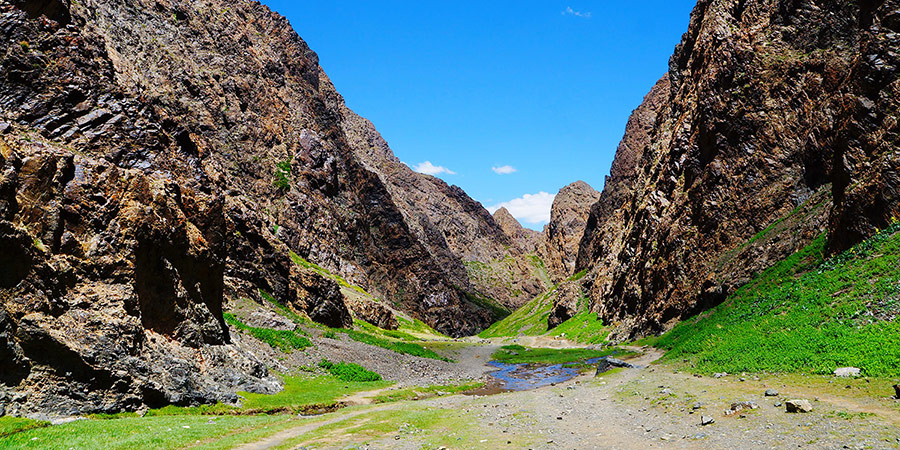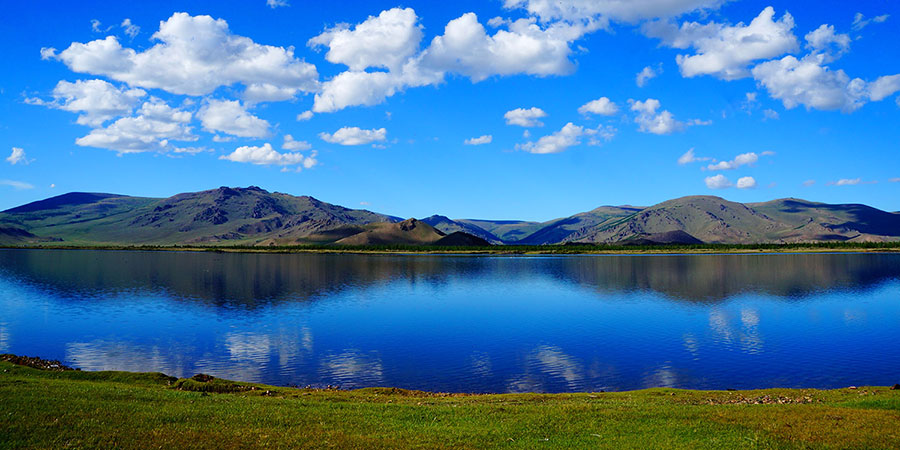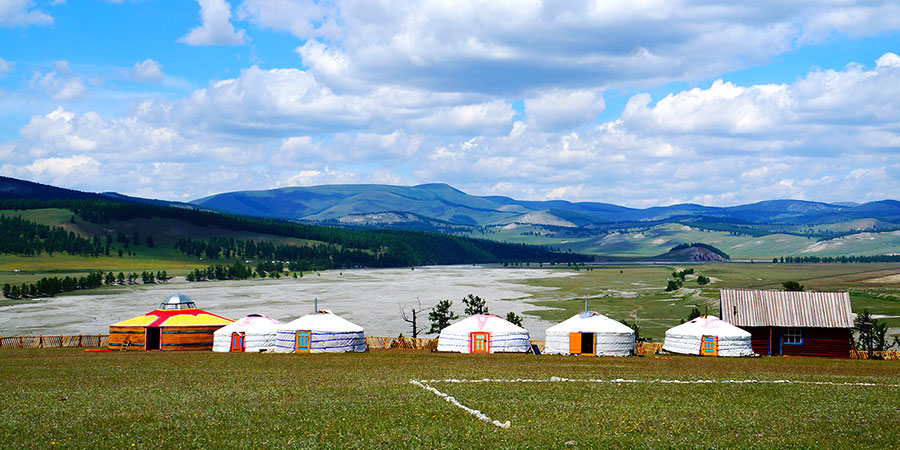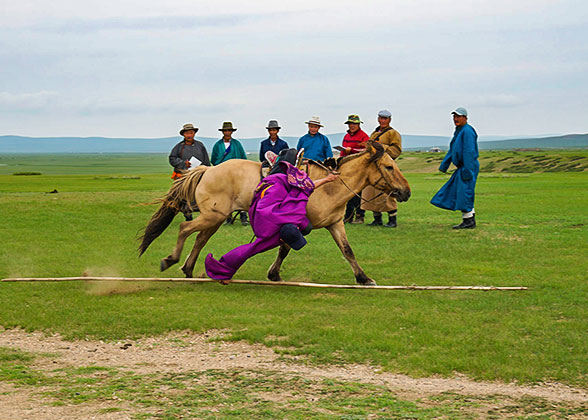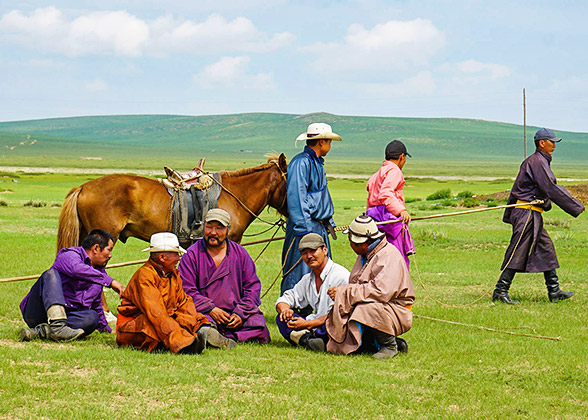Day 1: Airport Pick-up & Ulaanbaatar City Sightseeing
Thanks for choosing this Mongolia hiking tour! Today, our driver will pick you up at Ulaanbaatar airport or the train station and transfer you to the handpicked hotel downtown. During the rest of the day, the guide will escort you to visit some highlights in Ulaanbaatar. The first one will be Sukhbaatar Square, where important political and cultural events are always held. Surrounding it stand the State Parliament House, the Palace of Culture, and the State Opera and Ballet Theatre, etc. Then, visit the Museum of Mongolian National History to get a deeper understanding of Mongolian history and the majestic story of Genghis Khan’s west expedition. It is said that the Khan initially sought peaceful trade with the Khwarezmian Empire, but the 450 merchants he dispatched were killed by the governor of Khwarezm. Enraged by this behavior, Genghis Khan mobilized his armies and reduced Khwarezm’s cities to ashes. The campaign not only avenged his people but marked the beginning of his world-shaking Western conquests. Leaving the museum, you’ll attend an extraordinary Mongolian traditional music and dance show specially arranged as a welcome in the evening.  What Should I Do If I Need a SIM Card? Mobicom’s SIM card is recommended and available at the airport or downtown, which is cheaper. Generally, a package with 30 GB flow of data at the cost of USD 13 is valid for 15 days. The signal is good in city areas, but don't expect too much on mountainous or remote roads. Meals: Dinner Accommodation: Grand Hill Hotel Ulaanbaatar (4 stars) or similar
|
Day 2: Ulaanbaatar - Baga Gazriin Chuluu
After breakfast, our experienced guide will escort you to Baga Gazriin Chuluu, a big area of astonishing granite formations located in central Mongolia. It will take about 5 hours on the way, during which you can learn some local customs from the guide or appreciate the unique landscape outside the window. Feel free to ask for some photo stops. On arrival, check into a ger and have a short rest. In the afternoon, the guide will accompany you to explore the rock maze. There are also ancient inscriptions on the rocks and rare wildlife to see, such as marmots and wild mountain goats.  What Does a Ger Camp Look Like? Gers, known as yurts, are actually movable hotels. They are always located at the best viewing places, providing authentic traditional food and western-style buffets, offering tourists a real taste of Mongolian culture and adventure. We generally book the standard ger camps for you, which are only equipped with shared bathrooms. Ensuite ger camps with private bathrooms are twice as expensive. If you want to upgrade it, just let us know. Meals: Breakfast, Lunch, Dinner Accommodation: Erdene Ukhaa Tourist Camp or similar
|
Day 3: Baga Gazriin Chuluu - Tsagaan Suvarga (White Stupa)
This morning, we’ll set out for Tsagaan Suvarga, another natural wonder in Mongolia. It will also take about 5 hours to get there. You could enjoy the extraordinary landscape of the Gobi Desert on the way. On arrival, we'll check into the tourist camp and have lunch before exploring Tsagaan Suvarga. It is a canyon full of colorful rock formations eroded into various shapes by the wind year after year. It is locally known as "white stupa" because the rock formations just look like that from a certain angle.  How Long Do We Need to Stay on the Road Every Day? It depends on the destinations on the day. 80% of the road is countryside road, so the driving each day takes about 3-6 hours (100-290 km/ 62-180 miles) from one destination to the next, which is also influenced by weather conditions. But we can take breaks along the road for photographs, toilets, stretching, and meeting with local nomads. Meals: Breakfast, Lunch, Dinner Accommodation: Tsagaan Suvarga Tourist Camp or similar
|
Day 4: Tsagaan Suvarga - Eagle Valley (Yol Valley)
Eagle Valley is a narrow and deep gorge in the middle of the Gobi Desert. What makes it worth visiting is that the surrounding mountains are home to various endemic plants and rare animals such as argali, ibex, and bearded vultures. Besides, some parts of the valley are covered by ice almost throughout the year. On arrival from Tsagaan Suvarga by car, the guide will escort you to enjoy a hiking and photographing trip in the scenic valley.  What Kind of Road Do We Travel On? Of the main sightseeing spots in Mongolia, 20% of the roads are paved, while the rest are all countryside roads. Thus, a full-escorted itinerary is needed in Mongolia since traveling on roads without obvious signs can easily get one lost, but visitors will have a worry-free vacation with help from our professional guide and driver. Meals: Breakfast, Lunch, Dinner Accommodation: Juulchin Khanbogd Tourist Camp or similar
|
Day 5: Eagle Valley - Khongor Sand Dunes
Today, we’ll visit one of the largest sandy areas in Mongolia, Khongor Sand Dunes, with a length of 180 kilometers (110 miles) and a width of 3-5 kilometers (2-3 miles). At the northern border of the dunes, there is a small river flowing alongside the Seruun Bulag Oasis, which is covered with green and luxuriant vegetation.
★ Visit a Local Herdsman’s Family to Experience Authentic Nomadic LifeGetting there, we’ll firstly visit a local herdsman’s camp. The host is always happy if some tourists visit his ger or yurts because Mongols themselves are very hospitable, and the visit of tourists can increase their income. Suutei tsai, a traditional Mongolian milk tea, is loved by Mongolian people since there was a lack of vegetables on the grassland for generations, while suutei tsai can supplement the vitamins needed by the body perfectly. The herdsman always treats their guests with milk tea to show their respect. Take the chance to talk with the hosts to learn about the herdsmen’s lifestyle.
After, ride a camel to venture into the dunes to enjoy an excursion to the oasis, and then climb up to the top of a high sand dune to fully appreciate the magnificent desert landscape.
Meals: Breakfast, Lunch, Dinner
Accommodation: Gobi Discovery Ger Camp or similar
|
Day 6: Khongor Sand Dunes - Flaming Cliffs (Bayanzag)
After breakfast, we’ll drive 4 hours to Flaming Cliffs. It was named so because the cliffs here glow with a stunning fiery red light, especially at sunset. On the red land, low green shrubs grow tenaciously, and Gobi presents a rare beauty and brilliance under the blue sky. 65-100 million years ago, it was home to dinosaurs. In 1922, on the Gobi Plain, American scientists first discovered dinosaur fossils dating back 70 to 80 million years. Besides, many Neolithic stone tools were unearthed here, which make this place known as the cradle of world-renowned ancient humans and organisms. What’s more, the world’s first dinosaur eggs were found here. Our tour guide will show you around this area and leave you enough time to explore it. Why not try your luck to discover any dinosaur fossils? Meals: Breakfast, Lunch, Dinner Accommodation: Mongol Gobi Tourist Camp or similar
|
Day 7: Flaming Cliffs - Ongi Monastery
We’ll spend the morning, about 4 hours, traveling to Ongi Steppe by car. After settling down in the ger and having lunch on arrival, the guide will lead you to go for a walk along the Ongi River and then visit the Ongi Monastery. It was once one of the largest and most important monasteries of Mongolia, with nearly 30 temples and over 1,000 monks. Unfortunately, it was destroyed in 1939 during the anti-religious purges. Now, a temple and a museum have been rebuilt beside the ruins. After the guided sightseeing, you are free to explore the ruins in depth on your own during the rest of the day.
Meals: Breakfast, Lunch, Dinner
Accommodation: Ongi Secret Tourist Camp or similar
|
Day 8: Ongi Monastery - Karakorum - Erdene Zuu Monastery
Today will be a highlight of this Mongolia hiking tour, as we’ll visit the first UNESCO World Cultural Heritage of the country, the Orkhon Valley Cultural Landscape. To be specific, we’ll visit two representative sites of that cultural heritage, Karakorum and Erdene Zuu Monastery. It will take us about 5 hours to drive there from Ongi Monastery.
Karakorum was established as the capital of the Mongol Empire by Genghis Khan in 1220 and later grew into a world-class metropolis over the successive 200 years or so, consisting of an outer city and a palace city. Based on the ruins, we can see that it is an irregular rectangle with the southern and northern walls measuring 1,500 meters (4,920 feet) long and the eastern and western walls measuring 580-1,120 meters (1,900-3,670 feet) wide. A museum has been built beside the ruins to tell the history of the ancient city and the life stories of Genghis Khan. Erdene Zuu Monastery was built not far away in the 16th century after the fall of Karakorum. It is probably the oldest Buddhist monastery in Mongolia. Currently, it mainly consists of three temples and outer walls, on which 108 white stupas stand at a distance of about 15 meters (50 feet) from one another.
Meals: Breakfast, Lunch, Dinner
Accommodation: Munkh Tenger Tourist Camp or similar
|
Day 9: Tsetserleg - Terkh White Lake National Park
Today, we’ll first visit Tsetserleg, which is one of the greenest cities in the country, surrounded by mountains on four sides with the Tamir River flowing through. Next, head for Taikar Chuluu, a 20-meter-high (66-foot) cliff of granite engraved with different writings dating from the 6th century. The last stop of today will be the Khorgo Extinct Volcano inside Terkh White Lake National Park. The last eruption of the volcano was about 8,000 years ago. Its slope is covered with basalt, and its crater is 200 meters (656 feet) in diameter and 80 meters (262 feet) in depth. After coming down from the crater, we’ll set out for the camp near Terkh White Lake and stay there overnight.
Meals: Breakfast, Lunch, Dinner
Accommodation: Maikhan Tolgoi Tourist Camp or similar
|
Day 10: Terkh White Lake National Park
This whole day will be left for you to explore the scenic Terkh White Lake National Park on your own. Embraced by several extinct volcanoes, Terkh White Lake is one of the most beautiful lakes in Mongolia and an ideal place for hiking, horse riding, fishing, and swimming. In the evening, the guide will accompany you to visit a local family and learn about their daily life. Meals: Breakfast, Lunch, Dinner Accommodation: Maikhan Tolgoi Tourist Camp or similar
|
Day 11: Jargalant Hot Springs - Northern Mongolia
After breakfast, we'll drive through the vast steppe to northern Mongolia. Around noon, let’s take a short break at Jargalant Hot Springs. Afterward, keep driving north till reaching the selected camp to stay overnight. Today’s trip on the vast grassland will be a unique experience in your life. When passing by the scenic spots en route, just ask the driver to make stops and enrich this trip.
Meals: Breakfast, Lunch, Dinner
Accommodation: Ulziit Khishig Tourist Camp or similar
|
Day 12: Murun Town - Khovsgol Lake National Park
After breakfast, we’ll head to Khovsgol Lake, the largest freshwater lake in Mongolia. On the way, have lunch in the small town Murun and then drive 2 hours to Khatgal Village, where the guide will accompany you to visit its bazaar and port and observe the locals’ life. Khovsgol is also home to the Tsaatan Tribe, the last tribe of reindeer herders in Mongolia. If you visit here after August 15, you’ll have a chance to encounter them at the edge of the forest near the lake shore and visit their home to learn about their traditions and lifestyle. We’ll stay overnight at the ger camp by the lake.
Meals: Breakfast, Lunch, Dinner
Accommodation: Khuvsgul Eco Tour Camp Tourist Camp or similar
|
Day 13: Full Day at Khovsgol Lake National Park
Khovsgol Lake National Park is a great place for horse riding. This morning, you’ll be given some elementary instructions about horse riding, and then the guide will escort you to appreciate the landscape of the park on horseback. This afternoon will be left for your own plan. You may go to climb the nearby mountains, take a stroll by the lake, and take some great photos.  Lake Khovsgol & Mongolia’s Only Navy In 1930, Mongolia formed a navy aiming to defend the oil transportation on Lake Khovsgol. Later, this action was stopped to protect the environment. Since 2001, an old Russian tugboat named the Sukhbator has been put into use, equipped with seven crew members, for the shipping industry on Lake Khovsgol. The ship can sail along the Selenga River to Lake Baikal and then to the Arctic Ocean. Timber, livestock products, furs, coal, and minerals produced in Mongolia can be transported to Russia through this route and back with industrial materials. The Mongolian Navy did not engage in any military operations except for transporting goods. You may come across one of the members during your stay around Lake Khovsgol. Meals: Breakfast, Lunch, Dinner Accommodation: Khuvsgul Eco Tour Camp Tourist Camp or similar
|
Day 14: Murun Airport See-off & Fly back to Ulaanbaatar
This morning, the guide will send you to the airport in Murun Town. If time permits, visit the Uushig Ancient Deer Stone Monument en route. After seeing you off at the airport, our service in Mongolia will end here. Once you arrive at Ulaanbaatar airport, please connect your flight to the next destination by yourself. Contact us anytime if you need any help with your next destination!
Meals: Breakfast
|


